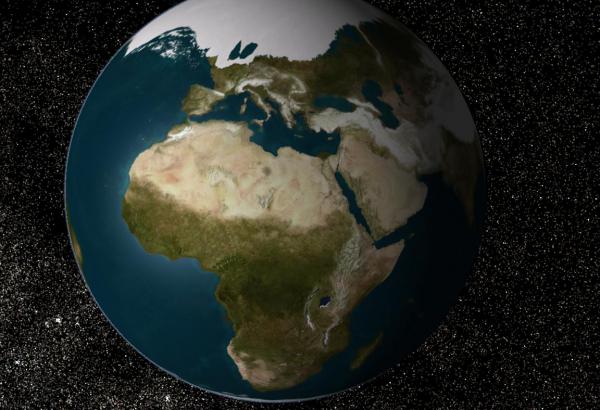BY LETTER
Ice Age
History > -13.7Gy to -7000 AT: Preterragen Era
History > 7800 to 9999 AT: Outer Volumes Era
Science > Planetology > Geology
Science > Paleontology
History > 7800 to 9999 AT: Outer Volumes Era
Science > Planetology > Geology
Science > Paleontology
 Image from Steve Bowers (using a texture by Don Edwards) |
Any period of prolonged and widespread glaciation on a terrestrial world.
Often used to refer specifically to the five major ice ages of Old Earth, traditionally known as the Gunz, Mindel, Riss and Wurm, although the most detailed surviving data indicates that the pattern of glaciation during this period was in fact quite complex, and many interglacial and interstadial periods occurred to divide the traditional ice ages still further. The most recent, or Gaiacene, episode of glaciation on Old Earth is known as the New Ice Age.
The causes of ice ages on Earth and other terrestrial planets are complex. Quite often small, temporary or permanent variations in CO2 content of the atmosphere or minor variations in the eccentricity of the orbit are sufficient to cause an ice age event. Sometimes the star is variable on a long term basis, and a lower level of insolation is the cause, but most stars gradually increase in luminosity over time due to the buildup of helium in their cores so this cause of glacial events is comparatively rare.
The New Ice age on Earth started in approximately 8600 AT, after the effects of Anthropogenic Global Warming finally disappeared.
Worlds currently undergoing ice ages are generally classified under the GaianTundral, TundralPelagic or TundralXeric Subtypes, and include Arcadia, Ihikkk, and Remagar.
Related Articles
- Arcadia (Beta Comae Berenices)
- Earth
- GaianTundral Subtype
- Ihikkk (Zeta Tucanae IV)
- Kragliath
- Milankovitch Cycles - Text by M. Alan Kazlev
Fluctuations in temperature on Garden Worlds, especially ice ages, caused by slight variations in the amount of sunlight reaching the planet caused by the eccentricity of its orbit around its primary. The orbital eccentricity changes the planet's average distance from the sun and therefore slightly changes the amount of sunlight reaching the Earth. Eccentricity cycles last over 100,000 years. The theory was first proposed by the Old Earth human Milutin Milankovitch in 31 AT (1938 c.e.). - New Dumont
- Remagar
- TundralPelagic Subtype
- TundralXeric Subtype
Appears in Topics
Development Notes
Text by Steve Bowers
Initially published on 09 April 2010.
Initially published on 09 April 2010.






